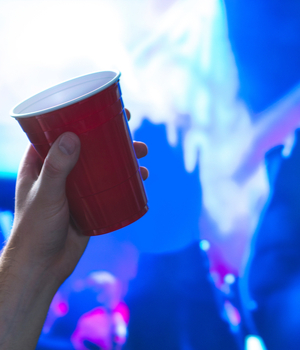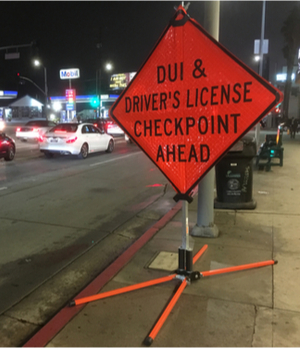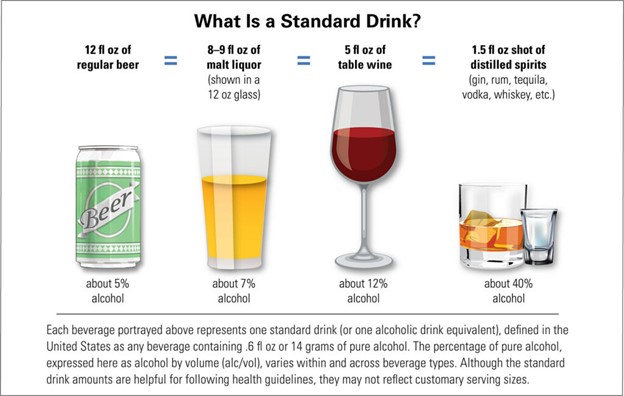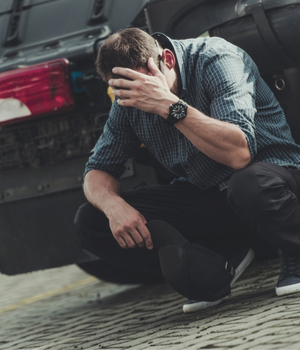Reading Time: 23 minutes

For many, drinking alcohol may seem part of the higher education experience. Booze-filled parties are almost considered synonymous with young people having fun in college these days. But in the blink of an eye, college drinking can turn into college alcoholism and long-term implications for a young adult who has their whole life ahead of them.
Alcohol abuse among college students is a significant public health problem that impacts the development of the brain, as well as students’ mental well-being and academic success, according to the National Institute on Alcohol Abuse and Alcoholism (NIAAA).1
Overview of College Drinking
 The college environment increases the likelihood of underage drinking, binge drinking and potentially more harmful drinking, characterized as alcohol abuse (or more recently referred to as alcohol misuse).
The college environment increases the likelihood of underage drinking, binge drinking and potentially more harmful drinking, characterized as alcohol abuse (or more recently referred to as alcohol misuse).
According to a national survey, almost 53 percent of college students drink, 9 percent of the college population have alcoholism (now called alcohol use disorder).2 Alcohol issues typically occur because students often find themselves in a culture that encourages binge drinking, and many see drinking as a large component of their college experience.
Currently, harmful and underage drinking are taking a significant toll – on students, their futures, their colleges, and those who come in contact with them while intoxicated. For example, 3,360,000 college-aged students drive under the influence of alcohol and there are over 6,000 alcohol-related injuries among college students each year.2
National Collegiate Alcohol Awareness Week 2022
One of the ways agencies and colleges are seeking to change drinking culture is through National Collegiate Alcohol Awareness Week (NCAAW) — an initiative run by the Coalition of Higher Education Associations for Substance Abuse Prevention (CoHEASAP).3
CoHEASAP was founded in 1983.3 Their mission is to promote education, prevention, research, networking, and national initiatives to help eliminate substance abuse among college students and the consequences college drinking causes.3 They do this in various ways, one of which is NCAAW.
During NCAAW, students have the opportunity to participate in a variety of awareness and educational events designed by the campus’ prevention partners and leaders. The events are designed to reinforce personal responsibility and respect for current state laws and policies when it comes to the consumption of alcohol beverages. Topics usually include safe drinking education, the risks of impaired driving and DUIs, and what students, parents, and colleges can do to keep students safe.4
This year’s NCAAW will be held October 1-21, 2022, and the event will see over 1000 colleges and universities come together to raise awareness about alcohol abuse and the dangers of impaired driving.3
“It is imperative that we change the drinking culture that afflicts our campuses.… But to effect real change, it must be realized that student leadership is essential. It is incumbent upon the entire campus community to get our students involved in setting responsible drinking guidelines, enforcing them, and helping those students who violate them.”
~ John Elrod, President, Washington and Lee University
College Drinking Statistics
College drinking is common, and full-time students drink more than others in their age group. In 2019, 53 percent of full-time college students drank alcohol in the last month, 33 percent binge drank, and 8 percent reported heavy drinking.2
Key college drinking stats:
There are various types of harmful drinking — also referred to as alcohol abuse — such as binge drinking or heavy drinking, which can lead to alcohol use disorder.
College Binge Drinking
Binge drinking is when a person consumes an excessive amount of alcohol in a short period of time and it brings blood alcohol concentration levels to 0.08 g/dL.6 That might look like four drinks for women and five drinks for men over a period of around two hours. College students in their first six weeks of college are at a much higher risk of binge drinking.
 Some of the risk factors contributing to binge drinking in college include:5
Some of the risk factors contributing to binge drinking in college include:5
- Widespread availability of alcohol
- Unstructured time
- Constant party atmosphere and the association of social time including alcohol
- Lack of enforcement of underage drinking laws
- Limited supervision
- Peer influence
- Expectations of and stressors on students, and social pressures.
While drinking when starting college may seem harmless, it can have some disastrous consequences. According to the National Council of Alcoholism and Drug Dependence, the potential impact of binge drinking includes academic problems, blackouts and an inability to remember what happened, driving under the influence, assault, sexual abuse, injury, property damage, unsafe sex, health problems, suicide attempts, involvement with the police, and death.6
College Alcoholism
Persistent binge drinking can lead to alcohol use disorder (AUD), according to the NIAAA.6 AUD is defined as “a chronic relapsing brain disease characterized by compulsive alcohol use, loss of control over alcohol intake, and a negative emotional state when not using.”6
Alcohol use disorder is a serious medical condition affecting an estimated 14.8 million Americans.29 According to the NIAAA, an estimated 88,000 people (approximately 62,000 men and 26,000 women) die from alcohol-related effects annually, making alcohol the third leading preventable cause of death in the United States.6
It is estimated that around 9 percent of college students, aged 18-22, meet the criteria for AUD according to a 2019 national survey, which are:7
- Drinking more or longer than intended
- Wanting to cut down or stop drinking, tried and couldn’t
- Spending a lot of time drinking, being sick from drinking, or getting over the aftereffects of drinking
- Experiencing strong urges or cravings for alcohol
- Finding that drinking interfered with day-to-day responsibilities, such as job, home, or school
- Continuing to drink in spite of its interference with life
- Cutting back on once-pleasurable activities in order to drink
- More than once getting into situations after drinking that caused a person to get hurt, such as unsafe sex, driving, using machinery, or walking in a dangerous area
- Continuing to drink despite feeling sick, anxious or depressed
- Having to drink more to experience the same effect
- Experiencing withdrawal symptoms once the alcohol wears off, such as sweating, shaking, irritability, anxiety, depression, restlessness, nausea, or sensing things that are not there
If you or your loved one is experiencing any of these symptoms, you should seek help from a medical professional who can perform an assessment and recommend treatment options.
Consequences of Heavy Drinking
Beyond the physical effects of heavy drinking, college students can also face a number of serious consequences that impact their lives now and long into their future.
The annual consequences of college drinking among students aged 18 to 24 include:
 Academic consequences: 1 in 4 students reported that drinking affected their studies due to missing classes, falling behind, performing poorly in exams, and receiving lower grades.8 Students who binge drank three times a week or more were around six times more likely to perform poorly on a test and five times more likely to have missed a class.8
Academic consequences: 1 in 4 students reported that drinking affected their studies due to missing classes, falling behind, performing poorly in exams, and receiving lower grades.8 Students who binge drank three times a week or more were around six times more likely to perform poorly on a test and five times more likely to have missed a class.8- Fatalities: Each year 1,519 students die from alcohol-related unintentional injuries, including motor-vehicle crashes.8
- Alcohol-related injuries: 599,000 college students who are under the influence of alcohol are unintentionally injured each year.8
- Hospitalizations: 22,219 college students are hospitalized for an alcohol overdose.8
- Assault: 696,000 students are physically assaulted by another student who has been drinking.8
- Sexual assaults: 97,000 (2%) were victims of alcohol-related sexual assault or date rape. It is estimated that 1 in 5 college women experience sexual assault.*9
- Impaired driving: 3,360,000 drive under the influence of alcohol.8
- Developing health issues: While 9 percent of students develop alcohol use disorder, many struggle with other mental health disorders such as anxiety and depression.8 Alcohol can also impact brain development and lead to learning difficulties, liver damage, high blood pressure, and inflammation of other organs.
- Committing criminal activities: Activities such as driving under the influence, abuse, assault and battery, vandalism, property damage, kidnap, homicide, and antisocial behavior.
- Suicidality: 1.5 percent of students admit to being suicidal due to alcohol use.8
- Other consequences: Additional problems include unsafe sexual behavior and sexually transmitted infections.8
*Figures for sexual assaults may be inaccurate because many sexual assaults are unreported, and when they are, sometimes survivors of assault aren’t believed because of being intoxicated at the time of the assault. Figures also overlook the fact that racial, sexual, and gender minorities are disproportionately impacted by sexual assault.10 However, new data reveals that transgender women are 300 percent higher odds of being sexually assaulted.10
Solutions for College Drinking
Ways to mitigate the damage of college drinking center around implementing collegewide strategies that include:
- Changing cultural perceptions and behaviors around alcohol use
- Reducing the availability of alcohol to people under the age of 21
- Increasing education about the serious effects of college drinking and impaired driving
- Improving law enforcement
- Providing Individual support from college counselors, including therapy, motivational interviewing, and referrals to recovery solutions
- Increasing access to treatment and recovery support services for students, such as collegiate recovery programs like the Association of Recovery in Higher Education.11
NIH has produced an interactive guide called CollegeAIM, a resource designed to help schools and colleges address underage student drinking.12 It lists many alcohol interventions, counseling options, and policies.
College Drinking and Driving Statistics
Research shows that drinking and driving among college students is common:13
Drinking impacts the ability to make accurate observations, concentrate, make sound decisions, use your best judgment, and react quickly. And being less capable of making a sound decision or react immediately, from applying the breaks or changing lanes, can result in a car accident.
Alcohol also significantly impacts your vision, causing:
- Images to appear blurry
- Vision to be less sharp
- Double-vision
- Impaired peripheral vision
- Reduced hand-eye coordination
Four Types of Impaired Driving
There are various types of impaired driving, each with its own features but all unsafe and can possibly put drivers, passengers and those who share the road at serious risk.
#1 Drunk Driving
 Drunk driving, as the name suggests, means driving while under the influence of alcohol placing the driver and others at risk, due to impaired judgment, focus, hand-eye coordination, and decision making. Unfortunately, drunk driving it’s common.
Drunk driving, as the name suggests, means driving while under the influence of alcohol placing the driver and others at risk, due to impaired judgment, focus, hand-eye coordination, and decision making. Unfortunately, drunk driving it’s common.
- Over 20 million people aged 16 or over drove under the influence of alcohol over the past year.15
- A staggering 50 percent of fatal car accidents among college-aged students were due to drunk driving.14
What to do: Don’t drink and drive. If you plan to drink, always arrange a designated driver, leave your keys at home, and make sure the person you are riding with has not been drinking. If you begin to suspect they have, ask them to pull over, do not be confrontational, suggest finding alternate ways to get home, and explain why you don’t want them to drive while under the influence. MADD provides additional tips on talking to someone who is intoxicated.16
#2 Drugged Driving
Drugged driving refers to operating a car under the influence of drugs (yes, that can include alcohol). Drugs like marijuana can slow reaction time, impair one’s ability to judge time and distance, and decrease coordination. Cocaine and other stimulants can make drivers more reckless. Drugs like opioids or benzodiazepines can cause the driver to feel drowsy, dizzy, and impact their thinking and judgment.17
Key drugged driving facts:
According to NIDA:
- 6 million adults over the age of 16 drove under the influence of illicit drugs in the past year.17
- The most 21-25-year-old’s drive when under the influence of drugs.17
- The most common drug taken while driving is alcohol, followed by marijuana, and drugs combined carries a greater risk of accidents.17
- 1 in 6 college students with a car had driven under the influence of marijuana in the last year.17
However, young adults are also affected by drugged driving because they’re less experienced drivers, less likely to be able to recognize dangers on the road, and they take greater risks. For example, research shows that drivers with THC – the main mind-altering ingredient in marijuana — in their blood were twice as likely to be involved in a fatal accident than those who hadn’t taken any drugs (including alcohol).17
What to do: Similar to drink drivers, do not use substances and drive, even if you think you’re capable. The statistics paint a different reality. Similarly, don’t get in a car with someone who has been taking drugs.
#3 Drowsy Driving
Drowsy driving means driving while feeling tired or sleepy. Operating a car while drowsy is dangerous because you may struggle to focus, have delayed reaction times, poor judgment, may misjudge distances and speeds, and may even fall asleep behind the wheel while driving.18
Drowsy driving accounts for:
- 100,000 accidents annually19
- 17,000 injuries19
- 1,550 deaths each year19
- Nearly 10 percent of crashes19
Unfortunately, 27 percent of drivers admitted to feeling sleepy while driving, and 1 in 25 actually fall asleep.19 It’s a myth to think only long car journeys cause drowsy driving, when in fact 47 percent of drivers who fell asleep while driving were on a trip of one hour or less.19
Even though drivers may be sober, sleep deprivation (18 hours or more without sleep) can have similar effects to blood alcohol levels of 0.5 percent, according to the Centers for Disease Control and Prevention.20
What to do: If you start to notice you are yawning or even nodding off, pull over. Roll your window down and breathe some fresh air. It might be best to arrange a ride home. If embarking on a long trip, ensure you get a good night’s sleep before driving, take breaks every two hours to nap or stay overnight, rather than driving through the night.
#4 Distracted Driving
Nine people in the United States are killed every day by drivers who are distracted.21 Distracted driving is defined as anything that takes your attention away from driving, such as:
- Texting while driving
- Talking on the phone
- Using a navigation system
- Eating while driving
According to the CDC, driving at 55 miles per hour while reading a text is like driving an entire football field with your eyes closed.21 The consequences of of distracted driving affect millions of Americans every year:
- 3,100 people are killed in crashes involving a distracted driver.21
- 424,000 were injured in a crash with a distracted driver.21
- 1 in 5 fatalities were people walking, riding their bikes, or outside of a car when involved in a crash with a distracted driver.21
- A higher percentage of drivers aged 15-20 were distracted while driving than those aged 21 or over.21
- 9 percent of younger drivers were distracted at the time of the crash.21
- 39 percent of high school drivers admitted to texting or emailing while driving in the last 30 days. These students were also more likely to get in a car with a drunk driver, drink and drive themselves, and not always wear a seatbelt.21
What to do: Turn your phone on do not disturb; only adjust car settings while at a complete stop, preferably parked; pull over to use your cell phone and if you must answer it while driving, do so on a hands-free device. Silence all non-urgent calls.
DUI Consequences for College Students
According to lawyers, the biggest consequences for either underage DUI or College Student DUIs include:
- High financial consequences for students and their parents – students may lose transportation, scholarships, financial aid, and may even lose their accommodation
- College athletes may lose their career, as some colleges suspend students with a DUI conviction
- Students enrolled in ROTC programs may be kicked out and denied military training
- A DUI may limit graduate school and professional opportunities, especially in a profession requiring licensure, like social work, medicine, nursing, etc.
- The college may decide to take disciplinary action against a student convicted of DUI
DUI Prevention
Research suggests that the occurrence of drinking and driving among college students depends on local policies and how they are enforced. Therefore, the most effective strategies are multidisciplinary, including prevention and enforcement efforts by the college, local policy department, and health agencies.
 On an individual level, there are a number of ways to prevent someone from driving while intoxicated. Here are a few tried and tested strategies:
On an individual level, there are a number of ways to prevent someone from driving while intoxicated. Here are a few tried and tested strategies:
- Prepare: Approach any conversation in as non-confrontational way as possible.
- Different transportation options: Suggest alternative ways of getting to a destination, such as a cab, rideshare, a sober driver, or public transportation.
- Consider your audience: The person you’re talking to is impaired and you may have to talk more slowly and clearly and be prepared to repeat yourself.
- Know your reasons: When speaking to a loved one, it’s important to compassionately explain that you don’t want them to hurt themselves or others.
- Have a backup plan: If you feel that your friend shouldn’t travel alone, suggest that they sleep over.
- Bring support: Ask a friend for moral support, and you’re more likely to be impactful together
- Safety first: If possible, ask friends who plan to drink to give up their keys before they start drinking.
How to Spot an Impaired Driver
Believe it or not, you can spot the signs impaired driver when you know what to look for. Here are a few signs that a driver might have been drinking:
- Frequent lane changing
- Tailgating
- Unreasonably slow (less than 10mph) or driving at fast speeds
- Swerving when passing
- Ignoring signals and signs
- Driving at night without lights
- Driving too close to the curb of shoulders, or straddling the middle lane
- Zig-zagging across the road
- Signaling that is inconsistent with driving actions
- Driving with the windows down in cold weather
- Approaching traffic signs either too slow or screeching the breaks
- Jerky starts and stops
- Turning abruptly or illegally
- Driving on the wrong side of the road
As a concerned citizen, it’s important to take action to get this person off the road as quickly as possible. Take the following steps if you spot an impaired driver:
- Stay as far away as possible from the driver
- Do not confront the driver
- Take a note of the license plate number, make and model of the car, and any distinguishing features. But don’t leave your car or compromise your safety trying to get this information
- Pull over and call 911 or locate state police to report your concern.
What are Blood Alcohol Content (BAC) Levels?
The body is very sensitive to toxins, like alcohol, as it can impair major bodily functions like the ability to make rational decisions, hand-eye coordination, and response times. The way alcohol and its effects are measured in the body is via blood alcohol concentration (BAC) levels, which essentially measures the concentration of alcohol in the blood. For example, a BAC of 0.08 means there is ⅛ of a drop of alcohol per 1,000 drops of blood.22
The following table outlines a range of blood alcohol concentrations and the likely effects on the average person.22
|
BAC Percentage Range |
Effects of Increased BAC Levels on an Average Person |
| 0.01 – 0.03 |
In California, a BAC of 0.01 percent in people under the age of 21 is considered impaired |
| 0.04 – 0.06 |
|
| 0.07 – 0.09 |
In California people over the age of 21 are considered impaired with a BAC of 0.08 percent |
| 0.10 – 0.12 |
|
| 0.13 – 0.15 |
|
| 0.16 – 0.20 |
|
| 0.25 – 0.30 |
|
| 0.35 – 0.40 |
|
| 0.40 & (and above) |
|
It’s important to note that there are several factors affecting BAC, including:23
- Gender: Males are more able to tolerate higher levels of alcohol than females. In women, the effects are stronger and last for a longer period. It is also thought that female composition, hormones, and body fat may also impact how alcohol is absorbed. Men also have higher levels of the enzyme that breaks down alcohol in the stomach before it enters the bloodstream.
- Mood: Alcohol can affect mood. So if a person is feeling depressed, they may drink more and feel more depressed. Those who are feeling tired may feel intoxicated more quickly than those who had a good night’s sleep the day before.
- Food in the stomach: Drinking on an empty stomach will increase the intoxication level more quickly than if you’d had a meal before going out, that’s because food slows down alcohol’s absorption into the lower intestine. Foods like protein, and fatty foods are more effective at slowing intoxication.
- Amount of alcohol consumed: The more alcohol you drink the more it increases circulation in the blood and raises BAC levels.
- Speed of consumption: Those who consume alcohol more quickly may feel the effects sooner than pacing themselves or drinking a glass of water between drinks.
- Tolerance to alcohol: People who have been binge or heavy drinking, may need to drink more to have the same effect.
- Physical condition: Illness, lack of sleep, stress, and any number of physical factors can affect the way the body processes alcohol.
- Medication/Drugs: Some drugs can make you feel drowsy, and many are labeled to avoid drinking alcohol while taking the medication.
- Altitude: Higher altitudes impact oxygen levels and can increase the potency of the alcohol, making you feel more intoxicated that you might normally drink the same amount.
BAC Calculator
It is possible, subject to the factors listed above, to calculate your blood alcohol concentration level. Our BAC Calculator tool asks you to enter your gender, weight, quantity of standard drinks (see how these are defined below), and the time since your last drink. The calculator will then give you a rough estimate of your BAC and list potential dangers.
Your BAC results will display here when you fill out the necessary criteria.
Drink Equivalencies
Drink equivalencies, simply means standard measures of certain drinks. A standard drink is defined as containing 14 grams of pure alcohol.22 Of course, each type of alcoholic drink is different, so a standard glass of wine (5 fluid ounces) may contain more volume in a standard drink compared to a standard drink of liquor (containing 1.5 fluid ounces).

Source: NIAAA Rethinking Drinking
In terms of normal drinking limits, NIAAA defines low-risk drinking as drinking no more than 7 drinks per week for women, and 14 for men.24 Anything above that, or more than 3 drinks in one session for women and four drinks for men, is considered binge drinking.24
Alcohol Cost Calculator
Drinking alcohol regularly can be expensive. Let’s say you drink five drinks on a night out, each one priced at $10 a drink – and you usually go out a minimum of twice a week with your college buddies. That scenario quotes to $400 a month and $4800 a year. One night might not seem impactful, but over time that adds up. There is a lot you can do as a college student with nearly $5,000, like saving toward a car for when you graduate, which will make finding work easier.
Want to find out how much you’re actually spending on alcohol as a college student? Try our alcohol cost calculator tool. You might be surprised to see how much cash you’re blowing on booze.
Your results will display here when you fill out the necessary criteria.
Myths About Quick Ways to Sober Up
College parties often put students in the futile situation of trying to sober up in an instance. Whether a person is too drunk to drive or they have a drunk friend making a public scene by fighting with their dormmate, a way to sober up quickly is desperately needed. But all the quick fixes in the world won’t make much difference because they’re by and large ineffectual.
There are numerous so-called “quick remedies” for sobering up fast, including:
- Drinking a cup of coffee
- Taking a cold shower
- Eating something fatty
- Making yourself vomit
Unfortunately, these alleged remedies are all myths. There is no quick way to sober up, other than having a good night’s sleep and drinking lots of water. However, it’s important to remember that leaving a severely intoxicated friend alone to sleep it off could be dangerous or even deadly, especially if they have alcohol poisoning.
What is Alcohol Poisoning/Overdose?
According to the NIAAA, thousands of students are taken to the emergency room each year with alcohol poisoning.25 Alcohol poisoning occurs due to high alcohol consumption rates. High levels of alcohol in the body suppress vital bodily organs and systems as they struggle to expel toxins. This is a serious condition that can result in permanent brain damage and even death.
Signs and Symptoms of Alcohol Poisoning
- Mental confusion
- Difficulty remaining conscious, or unable to wake up
- Vomiting
- Slow or irregular breathing
- Low body temperature (hypothermia) and pale skin
- Seizures
- Clammy skin
- Slow heart rate
- Dulled responses
If a person is showing any of these signs, they should seek immediate medical attention and call 911.
Stressors Affecting Student Drinking
Attending college can be extremely stressful, especially with coercion from peers to binge drink, impending deadlines, lack of sleep, and feeling completely overwhelmed.
According to the American Psychological Association, 61 percent of college students seeking counseling report experiencing anxiety.26 The American Institute of Stress reports that eight out of 10 students suffer from frequent stress.27 A further study showed that having parents with alcohol use disorder was a significant predictor of stress for college students.28
Despite nearly 20 percent of students suffering with AUD, only 1.2 percent received treatment for it.29
Student pressures at the start of the academic year, as well as social pressures, mean that the first six weeks of freshman year are the most vulnerable time for students to begin binge drinking and suffer its related consequences. According to NIAAA, students attending schools with strong Greek systems and prominent athletic programs are said to drink more heavily than students in other types of schools.6 What’s more, students living in fraternities and sororities consume the highest amount of alcohol. Students who live with their families have the lowest level of alcohol consumption.6
While college can lead to stress and feelings of being overwhelmed, it is entirely possible for students to manage that stress effectively. Solutions include prioritizing sleep, meditation and breathing exercises, using planning tools and schedulers, finding mutual aid groups, exercising, practicing yoga, eating well, and finding a creative outlet.
How to Keep Yourself and Your Friends Safe
As we have highlighted, drinking in college might be common, but it doesn’t need to be harmful to your health. Though college drinking may seem fun, the reality is that it isn’t without risk – academically, physically and emotionally.
Our top tips to keep you and your friends safe include:
- Always keep an eye on your drink and never leave it unattended
- Don’t drink alone
- Avoid mixing drinks and drugs
- Never operate a car or motorcycle if you have taken a drink or drug
- Always make a plan to get home safely before going out
- If your friend wants to drive home, always ensure they are sober and safe to do so
- Never take a ride from someone who has had a drink and/or taken a drug
- Try going out substance free and offering to be a designated driver
- If you do get in a car, wear a seatbelt, and observe the driver for any erratic driving. The moment you feel uncomfortable, ask the driver to stop the car and get out, making alternative arrangements to get home.
REFERENCES
- Understanding alcohol use disorder. (2021, April). National Institute on Alcohol Abuse and Alcoholism (NIAAA). https://www.niaaa.nih.gov/publications/brochures-and-fact-sheets/understanding-alcohol-use-disorder
- Substance Abuse and Mental Health Services Administration. (n.d.). Facts on college student drinking. https://store.samhsa.gov/product/facts-college-student-drinking/PEP21-03-10-006.
- National Collegiate Alcohol Awareness Week – coheasap. (n.d.). Coalition of Higher Education Associations for Substance Abuse Prevention. Retrieved August 12, 2022, from https://coheasap.myacpa.org/ncaaw/
- National Collegiate Alcohol Awareness Week. (n.d.). U Decide. Impaired Driving Prevention: https://collegesubstanceabuseprevention.org/ncaaw/2008/6+ImpairedDrivieStatsReferences.pdf
- TURRISI, R., MALLETT, K. A., MASTROLEO, N. R., & LARIMER, M. E. (2006). Heavy drinking in college students: Who is at risk and what is being done about it? The Journal of General Psychology, 133(4). https://doi.org/10.3200/GENP.133.4.401-420
- NIAAA. (2022, June). College drinking. National Institute on Alcohol Abuse and Alcoholism (NIAAA). https://www.niaaa.nih.gov/publications/brochures-and-fact-sheets/college-drinking
- SAMHSA, Center for Behavioral Statistics and Quality. 2019 National Survey on Drug Use and Health. Table 6.23B—Alcohol Use Disorder in Past Year among Persons Aged 18 to 22, by College Enrollment Status and Demographic Characteristics: Percentages, 2018 and 2019. https://www.samhsa.gov/data/sites/default/files/reports/rpt29394/NSDUHDetailedTabs2019/NSDUHDetTabsSect6pe2019.htm#tab6-23b.
- Consequences of college drinking. (n.d.). College Drinking Prevention. Retrieved August 3, 2022, from https://www.collegedrinkingprevention.gov/statistics/consequences.aspx
- Hingson, R., Heeren, T., Winter, M., & Wechsler, H. (2005). Magnitude of alcohol-related mortality and morbidity among U.S. college students ages 18-24: Changes from 1998 to 2001 – PubMed. Annual Review of Public Health, 26. https://doi.org/10.1146/annurev.publhealth.26.021304.144652
- UNIVERSITY OF PITTSBURGH SCHOOLS OF THE HEALTH SCIENCES. (n.d.). Sexual assault victimization disproportionately affects certain minority college students. EurekAlert! Retrieved August 3, 2022, from https://www.eurekalert.org/news-releases/777995
- Home. (2019, January 3). Association of Recovery in Higher Education: ARHE. https://collegiaterecovery.org
- CollegeAIM. (n.d.). CollegeAIM NIAAA’s Alcohol Intervention Matrix. College Drinking Prevention. Retrieved August 4, 2022, from https://www.collegedrinkingprevention.gov/CollegeAIM/
- Wechsler, H., Lee, J. E., Nelson, T. F., & Lee, H. (2003). Drinking and driving among college students. American Journal of Preventive Medicine, 25(3), 212–218. https://doi.org/10.1016/S0749-3797(03)00199-5
- Facts/Statistics. (n.d.). Drinking and Driving in College. Retrieved August 12, 2022, from https://drinkinganddrivingincollege.weebly.com/factsstatistics.html
- National Institute on Drug Abuse. (2019a, December 31). Drugged driving drug facts. National Institute on Drug Abuse. https://nida.nih.gov/publications/drugfacts/drugged-driving
- MADD. (n.d.). Concerned citizen. Mothers Against Drunk Driving. Retrieved August 12, 2022, from https://www.madd.org/get-help/concerned-citizen#Impaireddriving
- National Institute on Drug Abuse. (2019c, December 31). Drugged driving drug facts. National Institute on Drug Abuse. https://nida.nih.gov/publications/drugfacts/drugged-driving
- Borrelli, L. (2022, March 2). Drowsy driving statistics and facts 2022. Bankrate.Com. https://www.bankrate.com/insurance/car/drowsy-driving-statistics/#what
- National Safety Council. (n.d.). Fatigued driver. National Safety Council. Retrieved August 3, 2022, from https://www.nsc.org/road-safety/safety-topics/fatigued-driving/
- CDC. (2021, October 28). Drowsy driving can happen to anyone. Centers for Disease Control and Prevention. https://www.cdc.gov/sleep/features/drowsy-driving.html
- CDC. (2022a, April 26). Distracted Driving. CDC Injury Center. https://www.cdc.gov/transportationsafety/distracted_driving/index.html
- ABC. (n.d.). Alcohol facts. Alcoholic Beverage Control. Retrieved August 12, 2022, from https://www.abc.ca.gov/education/licensee-education/alcohol-facts/
- Overview of alcohol consumption. (n.d.). National Institute on Alcohol Abuse and Alcoholism (NIAAA). Retrieved August 2, 2022, from https://www.niaaa.nih.gov/alcohols-effects-health/overview-alcohol-consumption
- Rethinking Drinking. (n.d.). How much is too much – Rethinking Drinking. NIAAA. Retrieved August 4, 2022, from https://www.rethinkingdrinking.niaaa.nih.gov/How-much-is-too-much/
- College drinking. (2022, June). National Institute on Alcohol Abuse and Alcoholism (NIAAA). https://www.niaaa.nih.gov/publications/brochures-and-fact-sheets/college-drinking
- Winerman, L. (2017). By the numbers: Stress on campus. Monitor on Psychology, Vol 48(8), 88.
- Heckman, W. (2019, September 6). Stress: An epidemic among college students. The American Institute of Stress. https://www.stress.org/stress-an-epidemic-among-college-students
- Fischer, K. E., Kittleson, M., Ogletree, R., Welshimer, K., Woehlke, P., & Benshoff, J. (2000). The relationship of parental alcoholism and family dysfunction to stress among college students. Journal of American College Health, 48(4), 151–156. https://doi.org/10.1080/07448480009595690
- Substance Abuse and Mental Health Services Administration. (2021). Key substance use and mental health indicators in the United States: Results from the 2020 National Survey on Drug Use and Health (HHS Publication No. PEP21-07-01-003, NSDUH Series H-56). Rockville, MD: Center for Behavioral Health Statistics and Quality, Substance Abuse and Mental Health Services Administration. Retrieved from https://www.samhsa.gov/data/

 Academic consequences: 1 in 4 students reported that drinking affected their studies due to missing classes, falling behind, performing poorly in exams, and receiving lower grades.8 Students who binge drank three times a week or more were around six times more likely to perform poorly on a test and five times more likely to have missed a class.8
Academic consequences: 1 in 4 students reported that drinking affected their studies due to missing classes, falling behind, performing poorly in exams, and receiving lower grades.8 Students who binge drank three times a week or more were around six times more likely to perform poorly on a test and five times more likely to have missed a class.8